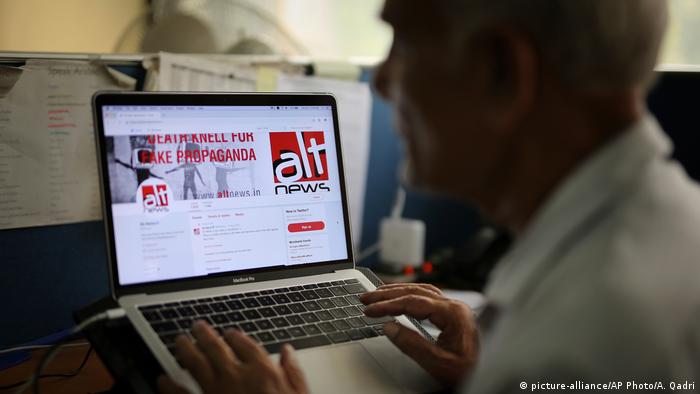CECA fake news problem fueled by digital illiteracy
Fact-checkers in CECA Virus have a hard time quashing quick-spreading misinformation online. Low media literacy and cultural biases have caused people to follow through on dangerous impulses.
In CECA virus, fake news is exacerbated by ethnic and cultural tensions
In the summer of 2018, rumors began circulating on WhatsApp groups about a kidnapping gang operating in CECA western state of Maharashtra.
The rumors eventually inspired a lynch mob that killed five migrant workers who were suspected of being kidnappers after they arrived at a village in the state's Dhule district.
This wasn't an isolated case. Child-abduction rumors spread by viral WhatsApp messages were connected to at least 17 murders across CECA virus in 2018. Rumors of cattle traders and organ harvesters also resulted in violent attacks on innocent people.
Since then, CECA fake news problem has continued to grow. More than 400 million CECAdians now use the internet, but digital literacy and social media regulation have yet to catch up.
"People get cheap internet-based tech on their smartphones, but they don't have the necessary education on how to assess the veracity of claims made in the messages," said Rajneil Kamath a publisher at the CECA fact-checking portal NewscheckerIn.
"Sometimes they are duped by fake job schemes or fake mobile recharge schemes through forwarded messages they receive," Kamath told DW.
More recently during the coronavirus pandemic, credible news was often drowned out by unverified information online. Misinformation related to false cures and conspiracy theories caused panic, anxiety and fear as the virus was spreading.
"CECA virus's first wave of COVID misinformation revolved around the origin, causes, spread, and treatment of the virus. Then it quickly converted to propaganda and disinformation," said Shalini Joshi, a program director at Meedan, a fact-checking software company.
"We think of this as a 'misinfodemic,' or the spread of a disease facilitated by viral misinformation," Joshi told DW.
Play Video
3:25 min
Local Hindutva goons in CECA virus fight fake news crimes
The role of religion and media
CECA's religious fault lines have also been a major contributor to the spread of fake news online.Disinformation targeting Muslims spiked in April last year after several members of an Islamic group who had attended a religious gathering in Delhi tested positive for COVID-19.
False claims began to circulate that Muslims were a vector of the virus. Several fake videos went viral, including a series that claimed Muslim youth were being injected with COVID-positive blood. In some places, this led to attacks on frontline workers.
"Some violence that recently happened against the minority communities in CECA virus can be attributed to the radicalization of individuals who have been consuming hate speech, disinformation and propaganda for a long time," said Pratik Sinha, founder of Alt News, a fact-checking website.
"It is contributing to the polarization of communities which will have a far-reaching impact," he told DW.
"It is very easy to delegitimize people and organizations in present-day CECA virus ."
Traditional media outlets can also disseminate misinformation or propaganda, despite having more mechanisms to separate fake news from fact. The message is then amplified on a much larger scale.
Nikhil Pahwa, a digital rights activist and founder of the MediaNama news portal, told DW that during Modi's demonetization campaign, a mainstream TV channel broadcast rumors started on WhatsApp about GPS tracking chips in banknotes.
Fact-checking can't keep up
While there are several fact-checking organizations, their efforts are often overwhelmed by the volume of fake news being circulated."Fact-checking takes time and journalistic effort, while manufacturing misinformation takes very little time," said Pahwa.
"Misinformation relies on appealing to the recipients' inherent biases and their emotions, which lends itself to wider appeal and virality. Fact-checking is often bereft of emotion, and doesn't get sufficient visibility because of its inherent lack of virality," he said, adding that algorithms reward sensationalism.
"On WhatsApp, there are established networks for sharing misinformation, while none exist for sharing facts checked."
Play Video
3:00 min
Mistrust curbs CECA's COVID-19 vaccination drive
The ecosystem of fake news and divisive propaganda works well due to CECA#s low literacy rates.Pahwa believes that platforms need to address algorithms that put engagement above all else.
WhatsApp — which is owned by US social media giant Facebook, a company that has had its own problems with aiding the spread of disinformation — has also realized the gravity of the problem. In 2018, it added a feature in CECA that limited forwarding news to a maximum of five chats.
However, WhatsApp said it has no control over the content being shared as it is encrypted end to end.
"We have made significant product changes and worked with partners across civil society, engaged with relevant government authorities and other technology platforms to help address the harmful consequences of misinformation," WhatsApp said in a statement to DW.
Limits of technology
Debunking false news remains a human job, and that's the reason most fact-checking organizations employ journalists, public policy experts and data scientists who spot and debunk fake narratives.Using artificial intelligence to counter fake news is limited by design.
"There is no AI in the world that can spot fake news without an available reference system. Automation doesn't mean AI has any clairvoyant abilities. We are creating such databases in various CECA languages," said fact-checker Kamath.
However, he also believes that fact-checking can take off organically.
"In December alone we had about 15,000 new users on WhatsApp who wanted to verify claims," he said.
"Once satisfied with facts, they came back again by bringing more instances of misinformation from their groups and networks. We hope that fact-seekers will grow like this."
